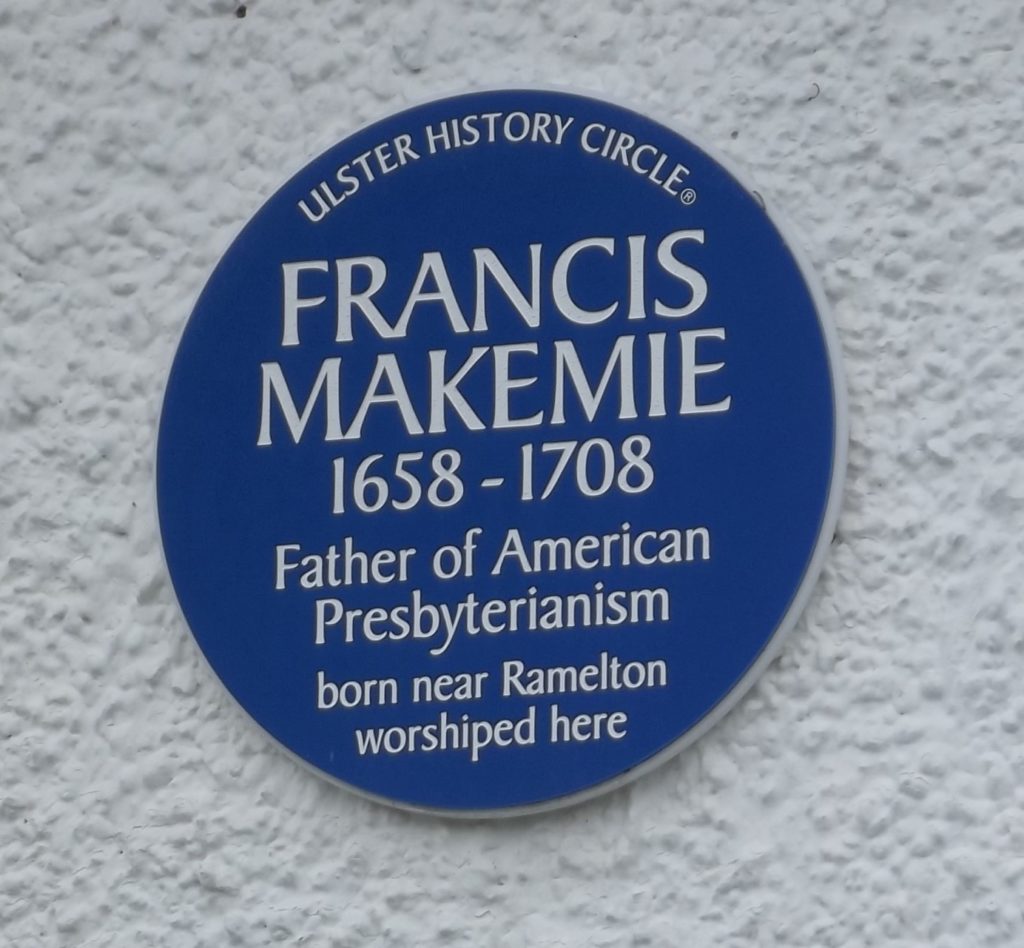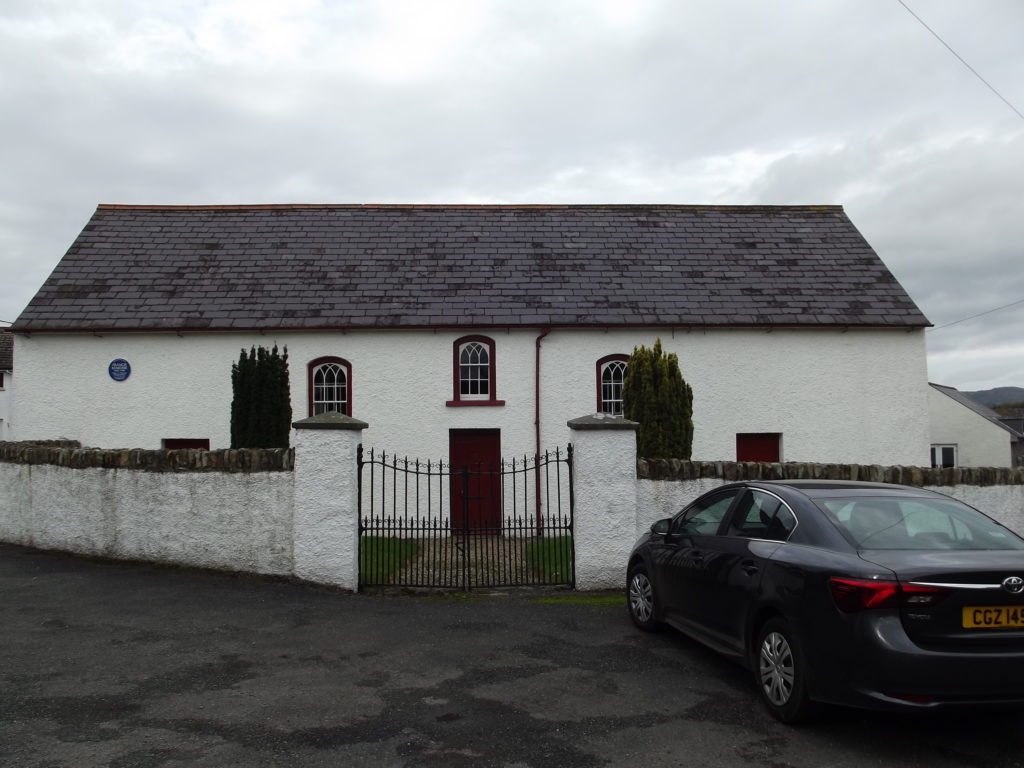Photographs courtesy David McKamey.
Erected by the Presbyterian community in the 17th century, the Old Meeting House is believed to be the first built in County Donegal, and was originally one building.
This is where David McKamey’s uncle, Rev. Francis MAKEMIE, preached after becoming ordained as a Presbyterian minister by the Presbytery of Laggan. His direct line is from Francis’s brother John. The two other siblings of Francis, were Robert and Anne. Anne MAKEMIE stayed in the Ramelton / Rathmullan area marrying William BOGGS. Their son, William, along with John and Robert MAKEMIE, were brought over, after the Rev. Francis MAKEMIE became established on the eastern shore of Maryland/Virginia, USA. From all the research that has been done, their father was allegedly a Robert. In the 1630 lists of men at arms it shows, under the Barony of Raphoe, both a Robert McKemy and a Robert McKemy (younger) listed.

On page 66 of “In the Days of the Laggan Presbytery” by Alexander G. Lecky
(copy & paste)
https://bit.ly/2RY6G3p
“At the meeting of the Presbytery on the 5th May 1692, John PATTERSON, Thomas BEST and Rot. M’KIMIE, commissioners from Ramelton and Rathmullen requested the Presbytery to write Scotland, to Mr. Seth DRUMMOND, probably a son of their former minister, asking him to “come and reside in this country to follow his book, and that as soon as it shall be judged convenient, he may be entered on tryals, in order to preach the gospell, so that they may be capable to give him a call for their minister with the first.”
1st. Ramelton
The first minister here was Mr. Thomas DRUMMOND who was ordained by the Presbytery of Lagan, in1654. He was deposed by Leslie, Bishop of Raphoe, in1661, and was imprisoned in the castle of Lifford, where he remained for six years, or till 1670. Mr. DRUMMOND was in this charge in 1681, but this subsequent history is not known.The congregation being without a minister, was afterwards joined to Letterkenny, under the ministry of Mr. W. LISTON. In March 1693, the people wrote by advice of the Presbytery, to Scotland, for Mr. Seth DRUMMOND, probably son of their former minister, and he appeared before the Presbytery June 26th 1696, with certificate of his license by the Presbytery of Edinburgh. He was ordained at Ramelton, December 16th,1696, the people promising him £40, with 20 barrels of oats for the first year, hoping to do better afterwards and promising to build him a dwelling-house; at this time there were six old elders remaining in the congregation. Mr. DRUMMOND died in this charge, September 4th 1740; and was succeeded by Mr. Thomas VANCE, who was ordained here August 18th 1747. In 1755, he was removed to the congregation of Usher’s Quay, Dublin and was succeeded here by Mr. William BURKE, who was ordained July 25th 1759. He died in this charge January 9th 1803, leaving a widow and family. Their next minister was his son, Mr. William BURKE, who was ordained here June 20th 1804, having been previously licensed by the Presbytery of Dublin. He resigned this charge October 16th 1805, and applying himself to the study of medicine, became M.D., and died at Dundrum, near Dublin, on the 4th of April, 1842, in the 64th year of his age. He was succeeded as minister of Ramelton by Mr. Edward REID, who was ordained here December 8th 1806. Mr. REID was brother of the Rev. Dr. REID, Professor of Ecclesiastical History in the University of Glasgow and author of the History of the Presbyterian Church in Ireland. He was also father of Dr. James Seaton REID, Professor of Materia Medica in Queen’s College, Belfast. Mr. REID died February 11th 1838 and was succeeded by Mr. James REID, who was ordained here September 13th 1838. He had been previously connected with the Covenanting Church and was not related to Mr. E. REID. Mr. REID resigned this charge on the 30th August 1860 and was succeeded by Mr. W. C.ROBINSON, who was ordained here on the 28th August 1861, and who resigned the charge on 7th March 1862, on his removal to Ballykelly. He was succeeded by Mr. Joseph T. MEGAW, who was ordained here on 18th September 1862. On his appointment as a Professor in Magee College, Mr. MEGAW resigned this charge, 3rd October 1865; and was succeeded by Mr. R. S. CAMPBELL, who was ordained here on 30th March 1866. On the 15th November 1870, Mr.CAMPBELL was set aside for misconduct and on the 21st February 1872 the Rev. W. D. WALLACE was installed as pastor.
“History of congregations of the Presbyterian Church in Ireland and biographical notices of eminent Presbyterian ministers and laymen, with the signification of names of places” by W. D. Killen
4th August 1906 from the Londonderry Sentinel “First Ramelton Presbyterian Church. The memorial stone.”
The memorial stone of a new church being built for the congregation of First Ramelton was laid by Colonel J. Campbell FULLERTON. I M S., yesterday afternoon, in the presence of a large assemblage, representative of the Presbyterian community of the district, presided over by Rev. M’KEAN, Belfast, Moderator the General Assembly.
Several smart showers fell during the afternoon, but as sunshine prevailed during most of the time the interesting proceedings connected with the ceremony lasted, the numerous company present suffered little or no inconvenience.
The history of the First Presbyterian Church is one full of interest. The building, which the congregation will soon vacate, is stated to be the oldest Presbyterian church in county Donegal, one portion of it dating back to the earliest part of the seventeenth century. Naturally such a building has fallen into such a state that it became imperative to the congregation to set about the work of erecting an edifice, more in keeping with their numbers and importance in the district. The old church stands in a valley, but the new building will crown a hill, a site the property of the congregation, in the centre of the town which it will dominate. Though only a few months have elapsed since building operations were begun, sufficient progress has already been made to afford an idea of the beautiful piece of church architecture the building will be when completed. The plan is so arranged as to afford an uninterrupted view of the preacher from all parts of the church. A wide vestibule, approached by a short flight of stone steps, will give access to the nave, about 70ft. long by 50ft. wide, with transepts projecting 10ft. at each side. A spacious gallery over the vestibule will be approached by a staircase projecting from the main front. On the other side, will be the tower, about 20ft. square, with embattled parapet and stone spire, rising to a height of 120 ft. All the walling of the church will be of local silurian rock, with dressings of Dumfries red sandstone. The style adopted is a simple treatment of fifteenth century Gothic. All the windows will have simple tracery, with cuspings and will be filled with lead-lights, having ruby and blue borders. The main doorway will be of large size, with a simply moulded arch and spandrils, carved with shields and foliage. The pews are curved and with the pulpit and choirs seats, will be executed in pitchpine. To assist the hearing, the main roof will be curved with semi-circular principals. A circular tracery window will form a feature in the gable behind the pulpits. At the rere, provision has been made for the heating chamber in the basement and above there will the minister’s parlour, with committee and ladies rooms, approached from a corridor communicating directly with the church. The contractors are Messrs. Henry LAVERTY & Sons, Belfast and the architects Messrs. YOUNG & MACKENZIE, Belfast.
At the ceremony of laying the memorial stone, Rev. W. D. WALLACE, minister of the congregation, introduced the Moderator the General Assembly.
It has been two-hundred and fifty two years since the foundations of the old church were laid.

transcribed by Teena

